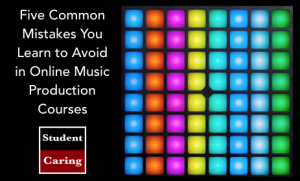Even if you follow all the rules there are in electronic music production there’s absolutely no guarantee that at the end of the exercise you are going to end up with a track that sounds great. Hence, it is vital that you do not commit any of the common production mistakes that can create problems that you will struggle to solve. To avoid the technical traps, you need to be aware of them.
Using Incorrect Algorithm for Time-Stretching
Using the warping mode of Ableton Live’s Beats to perform time-stretching of musical material is regarded as an extremely heinous act by the EDM community. While the Beats mode performs very well the function of preserving the rhythmic loop transients, it can unfortunately convert the material into a complete messhereby ruining the tune quality. The funny thing is that it takes just a simple step to correct the blooper; all you need to do is to select the Complex Pro mode to yield results that would be infinitely more pleasant. When you are sitting at your DAW, it can really be worthwhile to explore the various algorithms for time-stretching to establish their advantages and flaws.
Overcooking Masters
At one point of time EDM was all about how loud your music was but with portable music players, especially in the form of mobile phones ruling the roost, sound dynamics don’t seem to count anymore and it is not hard to figure out why! You can choose to go through the roof of your master bus – all you need to make sure is that there’s no audibly perceptible distortion, especially when the playback is through tinny speakers. The advantage of online music production courses is that they will invariably teach you to restrain yourself. If you suspect that you have crossed the limit, you should run a check using both monitor as well as headphones.
Using Poor Quality Material – A Strict No-No in Online Music Production Courses
In this day and age there are many who have sampled videos from YouTube. While purists may frown upon such practices, it could have its use when all you are attempting to do is to capture a cheeky vocal snatch or a sound that’s completely exotic. Unfortunately, many music producers have become accustomed to listening to music from a variety of very low fidelity devices such as laptops, mobile phones, and portable speakers so they have no idea of the quality of audio delivered by a CD. With their limited vision, they end up sampling even sounds with inbuilt transients from video channels on the Internet. What is truly agonizing that there are so many places from where they can obtain completely free of charge WAV samples that are 24-bit.
Using Samples That Are Not Tuned or Are Clashing
If your ears are not especially perceptive, sample layering and tuning can be extremely tricky. While the best way is to spend years developing a keen sense of music, if you are a man in a hurry you can always take recourse to a couple of very handy plug-in like Photosounder Spiral CM and Vengeance-Sound Scope to conduct a proper analysis. You should also pay attention to tuning the sounds of the drum that unless polished can prevent an otherwise decent track from sounding as impactful as it deserves to be.
Incorporating Too Many Sound Elements
While it can always be debated that the number of sound elements to be included in a track is a creative decision rather than a technical one, it is almost certain that your track will sound messed up if you have too much happening there. Know for sure that the audience that now primarily comprises cell phone-toting youngsters would possibly not be able to make out so many elements so you can very well omit them and incorporate instead high decibels.
We welcome your feedback to our work.
Email: General Information | Dr. Daniel de Roulet | Prof. David C. Pecoraro
Thank you!
Daniel & David
###
Five Common Mistakes You Learn to Avoid in Online Music Production Courses


0 Comments